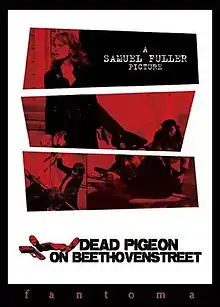Dead Pigeon on Beethoven Street
Dead Pigeon on Beethoven Street (German: Tote Taube in der Beethovenstraße) is episode 25, season 1, of Tatort, a German police procedural television program, directed by Samuel Fuller.[1] It was given a theatrical release in the United States by Emerson Film Enterprises in 1975. A novelisation by Fuller appeared in the US.
| Dead Pigeon on Beethoven Street | |
|---|---|
 | |
| Directed by | Samuel Fuller |
| Written by | Samuel Fuller |
| Starring | |
| Cinematography | Jerzy Lipman |
| Edited by | Liesgret Schmitt-Klink |
| Music by | Can (as The Can) |
| Distributed by | Emerson Film Enterprises (U.S.) |
Release dates | 20 August 1972 (Edinburgh International Film Festival) 7 January 1973 (German TV) |
Running time |
|
| Country | West Germany |
| Language | English |
Overview
An American private detective is killed in Germany while possessing incriminating photos, and his partner (Glenn Corbett) seeks revenge. Joining with the seductive blonde (Christa Lang) who appeared in the photos, the investigator hopes to discover who was behind them, and why his partner was killed for having them.
Production history
Fuller was offered the opportunity to direct an episode of the popular German crime drama by film critic (and later writer/director) Hans-Christoph Blumenberg in appreciation for the director's help in securing interviews with filmmakers Howard Hawks and John Ford for a documentary project. Upon meeting with the program's producers and feeling initial doubts about being able to conform to the show's standard template, he suggested a storyline inspired by the then-recent Profumo affair in England, which the producers approved to Fuller's surprise.[2]
Fuller's screenplay took liberties with the established style of the show by eliminating a primary series protagonist early in the episode in order to introduce a one-time American character to helm the investigation, by conducting the majority of the program in English rather than German (though subtitles were provided in the German broadcast), and by ultimately treating the story with a satirical and often broadly comic tone.
Restoration
In March 2015, the UCLA Film and Television Archive premiered a restored director's cut which added additional footage previously unseen in its television broadcast or theatrical release.[3]
References
- Sandra Brennan (2008). "Dead Pigeon on Beethoven Street". Movies & TV Dept. The New York Times. Archived from the original on 2008-01-10.
- Iseeadarktheater.com
- "Dead Pigeon on Beethoven Street (Germany, 1972) Tote Taube in der Beethovenstraße". UCLA Film and Television Archive. 2015.